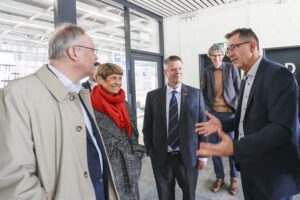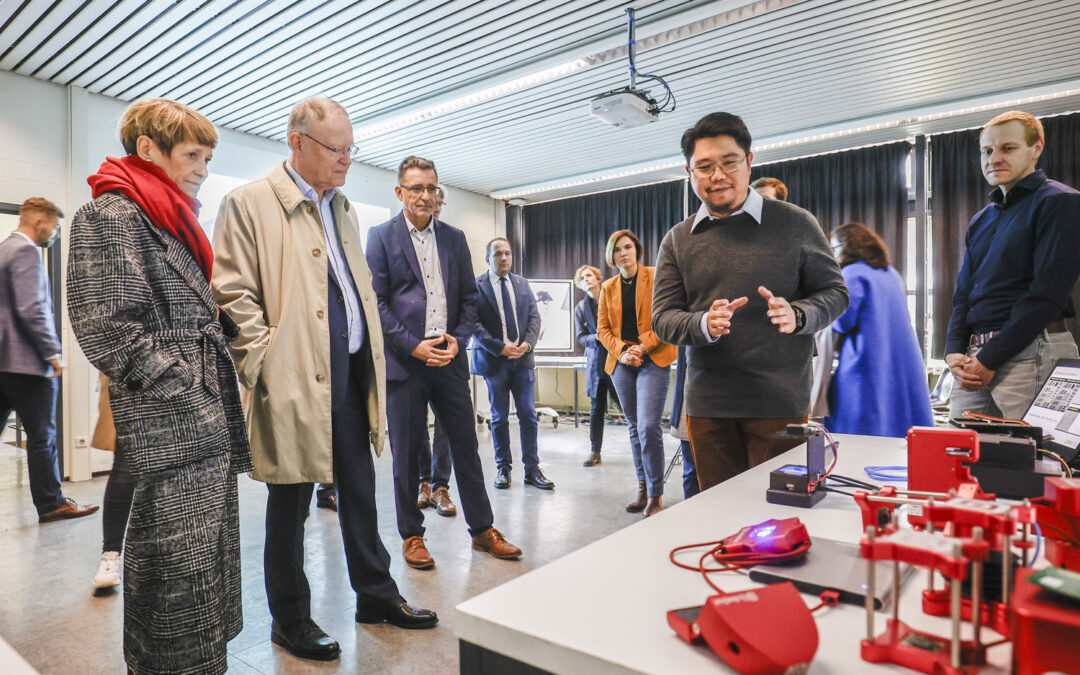When the headlight starts thinking
The Nitride Technology Center (NTC) presents itself: During his visit to TU Braunschweig, Minister President Weil dived into the world of microelectronics on 23 October 2023. Nitride semiconductors are becoming the second innovative pillar of microelectronics alongside silicon technology. It is one of the system-critical competencies of a modern society with considerable value-added potential. Accordingly, the European Commission promotes nitride technologies with IPCEI (Important Projects of Common European Interest) and the European Union included them in the so-called Chip Acts, which is intended to shape Europe’s digital future.
The Nitride Technology Center (NTC) brings together Lower Saxony’s strengths in nitride technology. With the NTC, Lower Saxony aims to exploit the opportunities of nitride technology, but also addresses the challenges of the need for skilled workers in microelectronics. Germany and Europe are strongly positioned in nitride technology with globally leading companies such as ams OSRAM or Infineon. But the clustering of Lower Saxony’s activities in semiconductor technology is also important in view of the Intel site 80 km east of Braunschweig, with more than 30 billion in investments and a staff requirement of 3,000 employees in 2027. Furthermore, nitride technology is an innovation source for start-ups.
The core of the NTC is formed by the LENA research centre of the TU Braunschweig and its Institute of Semiconductor Technology. Braunschweig’s semiconductor technology has many years of expertise in nitride technology and is one of the few university institutes worldwide to work on the entire research chain from material production to chip processing and hybrid integration to system integration. The institute is linked to ams OSRAM, one of the market leaders in nitride-based photonics, in a long-standing strategic cooperation, the Epitaxy Competence Center (ec²).
In future, the NTC will also integrate groups working on CMOS design as well as power and high-frequency electronics. Further contributions are made by partners from Leibniz University Hannover, Georg-August University Göttingen and Ostfalia University of Applied Sciences. The lasers and optical systems from the NTC are also needed for the control, miniaturisation and scaling of quantum processors. The NTC is therefore also an important building block of Quantum Valley Lower Saxony (QVLS) and for the Cluster of Excellence QuantumFrontiers, which is jointly supported by TU Braunschweig, Leibniz University Hannover and the Physikalisch-Technische Bundesanstalt as well as other partners.
An optical brain
During his visit to the NTC, Mr Weil was able to see a special demonstrator and watch an optical brain – or an optical neuromorphic network – in operation.
 An EVIYOS microLED matrix, provided by ams OSRAM, in combination with a programmable optical filter, serves as the basis for an optical neural network. The network is taught to recognise handwritten digits from 0 to 9 without the need for a conventional microprocessor. Each pixel of the EVIYOS corresponds to a neuron. The input matrix of the image is multiplied by the weighting matrix of the filter – purely optically, without any digital processors. The result is a categorisation of the input pattern into 10 categories – in this case the 10 digits from 0 to 9.
An EVIYOS microLED matrix, provided by ams OSRAM, in combination with a programmable optical filter, serves as the basis for an optical neural network. The network is taught to recognise handwritten digits from 0 to 9 without the need for a conventional microprocessor. Each pixel of the EVIYOS corresponds to a neuron. The input matrix of the image is multiplied by the weighting matrix of the filter – purely optically, without any digital processors. The result is a categorisation of the input pattern into 10 categories – in this case the 10 digits from 0 to 9.
Why is pattern recognition such a complex task, at least for conventional microprocessors? A pattern can only be identified if the whole pattern – for example the image of a digit – is seen at the same time. A conventional microprocessor has the information separated and digitised in its memory, and fetches the pattern bit by bit into the computational register. This inefficient approach leads to comparatively enormous power consumption. Our brain, as a fascinating neural network, is much more efficient. The brain operates at only 10 hertz instead of the billions of hertz of a computer and still recognises complex patterns almost effortlessly.
The reason: our brain works completely differently. It is networked in parallel, perceives a pattern holistically and then also processes it holistically. In this “in-memory computing”, all information is available simultaneously and side by side. This is exactly what happens in the LED-based demonstrator shown, programmed as an optical neuromorphic network. The EVIYOS modules, which are actually basic modules for matrix headlights, thus start to think.
